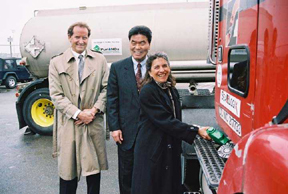First of Its Kind Test of Cleaner Fuel and Exhaust Control Equipment on Heavy Duty Trucks That Haul Shipping Containers

Published: February, 2004
The Port of Oakland announced a year-long demonstration test of a cleaner fuel (PuriNOx™) in on-road diesel trucks that haul shipping containers to and from the Port’s marine terminals in combination with a test of a diesel oxidation catalyst, or DOC (AZ Purimuffler™)--a type of exhaust control that reduces emissions. The Port, Air District, and the Air Resources Board are funding the $148,000 project.
“We are very excited about the potential this project holds for demonstrating a significant reduction in diesel emissions,” said Tay Yoshitani, Port of Oakland’s executive director. “If it works the way we expect, the new cleaner fuel and exhaust control will offer a workable option for the local trucking industry to improve air quality, something that we would all like to achieve,” added Yoshitani.
Port of Oakland Maritime Director Jerry Bridges commented that this project is precedent-setting, “Oakland is the first port in the country to conduct this type of demonstration project--to show the emission control benefit of using the combination of the PuriNOx™ cleaner fuel and the AZ Purimuffler™ on heavy-duty trucks that haul shipping containers to and from a port. There have been tests involving off-road port vehicles, but now we’re trying this out on trucks that take to the highway.”
A dozen heavy-duty diesel trucks from Horizon Lines will be used for the demonstration testing. Bill Alverson, Horizon Lines’ terminal operations manager, commented on his company’s participation in the project, “We are delighted to be on the cutting edge of experimenting with new fuel and exhaust control technology, knowing our involvement may help the environment.”
Two Horizon trucks will be unchanged for baseline control; two will be outfitted with the AZ Purimuffler™ DOCs made by Lubrizol ECS; four will be fueled with PuriNOx™; and four will have an AZ Purimuffler™ DOC and be fueled with PuriNOx™.
Jack Broadbent, the Air District’s executive officer, stated, “This project offers great promise to further protect public health in the West Oakland community. And, the possibility that similar diesel reductions could be duplicated throughout the Bay Area and beyond is extremely encouraging.”
Port officials thanked members of the West Oakland community for their dedication in working to improve air quality. Port Director of Communications Harold Jones said, “ Our neighbors in West Oakland came to us and we listened. This project is one example of many projects that the local community and the Port have put together in an effort to find new ways of improving air quality.”
PuriNOx™ was developed by The Lubrizol Corporation and is manufactured by blending standard California diesel with purified water and the PuriNOx™ additive package. It virtually eliminates “black smoke.” It is locally blended and distributed by Ramos Oil Company.
The Lubrizol Corporation’s Market Development Manager for Emulsified Products Bill Hagstrand explained how PuriNOx™ works, “Blending water with diesel fuel lowers the peak combustion temperature, thereby reducing nitrogen oxides in emissions. The fuel also delays the initiation of combustion, leading to lower particulate emissions. Basically we are talking about a technical concept, but a relatively simple way of controlling pollution so that we can all breathe a little easier.”
This demonstration project will also use six AZ Purimufflers™ made by Lubrizol ECS, a Newmarket, Ontario (Canada)-based division of The Lubrizol Corporation. ECS President, Ed Richards, said that DOCs typically reduce particulate matter emissions 20 to 30%. “Now that our AZ Purimufflers™ will be used along with PuriNOx™ in the diesel trucks, it could result in as much as a 50% reduction in particulate matter and a 20% reduction of nitrogen oxide emissions.”
This project is part of the Port’s nearly $9 million Vision 2000 Air Quality Program. In 1999, the Port embarked on a harbor expansion program known as the “Vision 2000 Maritime Development Program.” As part of the expansion program and to mitigate local impacts from its operations, the Port agreed to establish an air quality program. The program’s projects are designed to reduce air emissions from many sources, including marine terminal equipment, tugboats, local buses, and trucks. Several of these projects have been completed, and more are underway.

